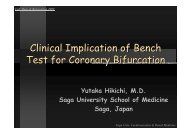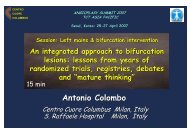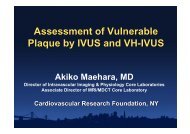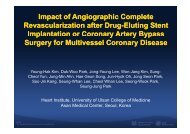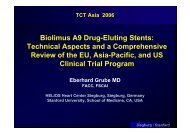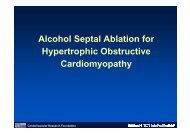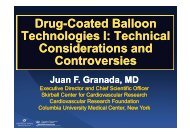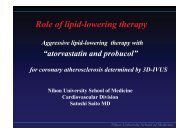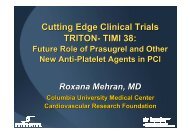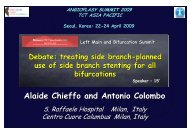Edge-to Edge Mitral Repair with the Evalve Mitra ... - summitMD.com
Edge-to Edge Mitral Repair with the Evalve Mitra ... - summitMD.com
Edge-to Edge Mitral Repair with the Evalve Mitra ... - summitMD.com
You also want an ePaper? Increase the reach of your titles
YUMPU automatically turns print PDFs into web optimized ePapers that Google loves.
<strong>Edge</strong>-<strong>to</strong> <strong>Edge</strong> <strong><strong>Mitra</strong>l</strong> <strong>Repair</strong> <strong>with</strong> <strong>the</strong><br />
<strong>Evalve</strong> <strong>Mitra</strong>-clip<br />
EVEREST TRIAL UPDATE<br />
Ted Feldman MD, FACC, FSCAI<br />
April 29 th th , 2005
Recurrence of <strong><strong>Mitra</strong>l</strong> Valve Regurgitation After<br />
<strong><strong>Mitra</strong>l</strong> Valve <strong>Repair</strong> in Degenerative Valve Disease<br />
• n=242<br />
• Degenerative MR<br />
• 91% survival<br />
• 94% freedom from re-operation<br />
• Linearized recurrance rate<br />
• >1/4 8.3%/year<br />
• >2/4 3.7%/year<br />
Development of M<br />
80<br />
70<br />
60<br />
50<br />
40<br />
30<br />
20<br />
10<br />
0<br />
5.7<br />
MR Grade<br />
>1/4 >2/4<br />
1.7<br />
41.4<br />
17.2<br />
72.8<br />
28.9<br />
1 Month 5 Years 7 Years<br />
Circulation. 2003;107:1609
“Bow<br />
- Tie” <strong>Repair</strong>
Flow Dynamics Support <strong>the</strong><br />
<strong>Edge</strong>-<strong>to</strong>-<strong>Edge</strong> <strong>Repair</strong><br />
• Ssys<strong>to</strong>lic flow occurs at high<br />
ventricular pressure and drives<br />
leaflets closed<br />
• Ddias<strong>to</strong>lic flow occurs at low<br />
ventricular pressure and drives<br />
leaflets open<br />
• Llow stress at <strong>the</strong> E-2-E<br />
apposition point
Images in Cardiovascular Medicine<br />
Alfieri <strong><strong>Mitra</strong>l</strong> Valve <strong>Repair</strong><br />
Clinical Out<strong>com</strong>e and Pathology<br />
Circulation. 2002;106:e173
Double Orifice Technique<br />
Without annuloplasty n=160<br />
Maisano F. Caldarola A. Blasio A. De Bonis M. La Canna G. Alfieri O. Midterm results of edge-<strong>to</strong>-edge mitral<br />
valve repair <strong>with</strong>out annuloplasty. Journal of Thoracic & Cardiovascular Surgery. 126:1987-97, 2003
Apples<br />
Oranges
Endovascular CVRS for E2E <strong>Repair</strong><br />
(Cardiovascular Valve <strong>Repair</strong> System)
Off-pump <strong>Edge</strong>-<strong>to</strong>-<strong>Edge</strong> <strong><strong>Mitra</strong>l</strong> Valve Technique<br />
Using a Mechanical Clip in a Chronic Model<br />
Clip repair in porcine heart (6 mos post repair)<br />
Fann JI, St Goar FG, Komtebedde J, Oz MC, Block PC, Foster E, Butany J, Feldman T, Burdon TA:<br />
Beating heart ca<strong>the</strong>ter-based-edge-<strong>to</strong>-edge mitral valve procedure in a porcine model; efficacy and healing response.<br />
Circulation 110:988-993, 2004
Edwards Delivery System<br />
• Therapy ca<strong>the</strong>ter – 10F<br />
• Percutaneous deflectable<br />
guide ca<strong>the</strong>ter<br />
• Fastener ca<strong>the</strong>ter – 6F<br />
•Low profile<br />
• Flexible
Moderate <strong>to</strong> Severe (3+) or Severe<br />
(4+) <strong><strong>Mitra</strong>l</strong> Regurgitation<br />
• Symp<strong>to</strong>matic or<br />
• Asymp<strong>to</strong>matic <strong>with</strong><br />
• LVEF < 60% and/or LVESD 50-55, or<br />
• LVEF 50-60 and LVESD < 45 mm, or<br />
• LVEF >60 and LVESD 45-55
Intra-procedure echo guidance
Hemodynamic Results
Clinical Features<br />
n = 27<br />
Age (mean)<br />
Male gender<br />
Diabetes mellitus<br />
Hypertension<br />
COPD<br />
His<strong>to</strong>ry CHF<br />
Atrial Fibrillation<br />
NYHA III/IV<br />
68.6 years<br />
59%<br />
15%<br />
63%<br />
18%<br />
59%<br />
41%<br />
44%
MR Etiology<br />
n=27<br />
Degenerative<br />
25 (93%)<br />
P2 Prolapse/Flail<br />
Bi-leaflet Prolapse/Flail<br />
A2 Prolapse/Flail<br />
14 (56%)<br />
10 (40%)<br />
1 (4%)<br />
Ischemic<br />
2 (7%)
Primary Endpoint<br />
30 Day Major Adverse Events<br />
n= 27<br />
FREEDOM FROM 30-DAY MAE<br />
Death<br />
Permanent Stroke<br />
Cardiac Surgery for failed clip<br />
Partial Clip Detachment<br />
Clip Embolization<br />
Myocardial Infarction<br />
Cardiac Tamponade<br />
Septicemia<br />
85%<br />
0<br />
1<br />
0<br />
3<br />
0<br />
0<br />
0<br />
0<br />
4/27 (15%)
Patients Discharged <strong>with</strong> a Clip<br />
MR ≤ 2+ at One Month was<br />
Maintained at 6 Months in 93% of Patients<br />
2 •2 partial clip detachments<br />
2<br />
4<br />
6<br />
1<br />
5<br />
8<br />
8<br />
MR ≤2+ 93%<br />
1 Month<br />
6 Months<br />
MR Severity<br />
4 3 2 1
EVEREST II Study Design<br />
• Prospective, randomized, multi-center study<br />
• Control: surgical mitral valve repair or replacement<br />
• Patients randomized 2:1<br />
• Primary Effectiveness Endpoint<br />
• Freedom from surgery for Valve Dysfunction, death, and<br />
moderate <strong>to</strong> severe (3+) or severe (4+) mitral regurgitation at<br />
12 months<br />
• Primary Safety Endpoint<br />
• Freedom from MAE at one month



